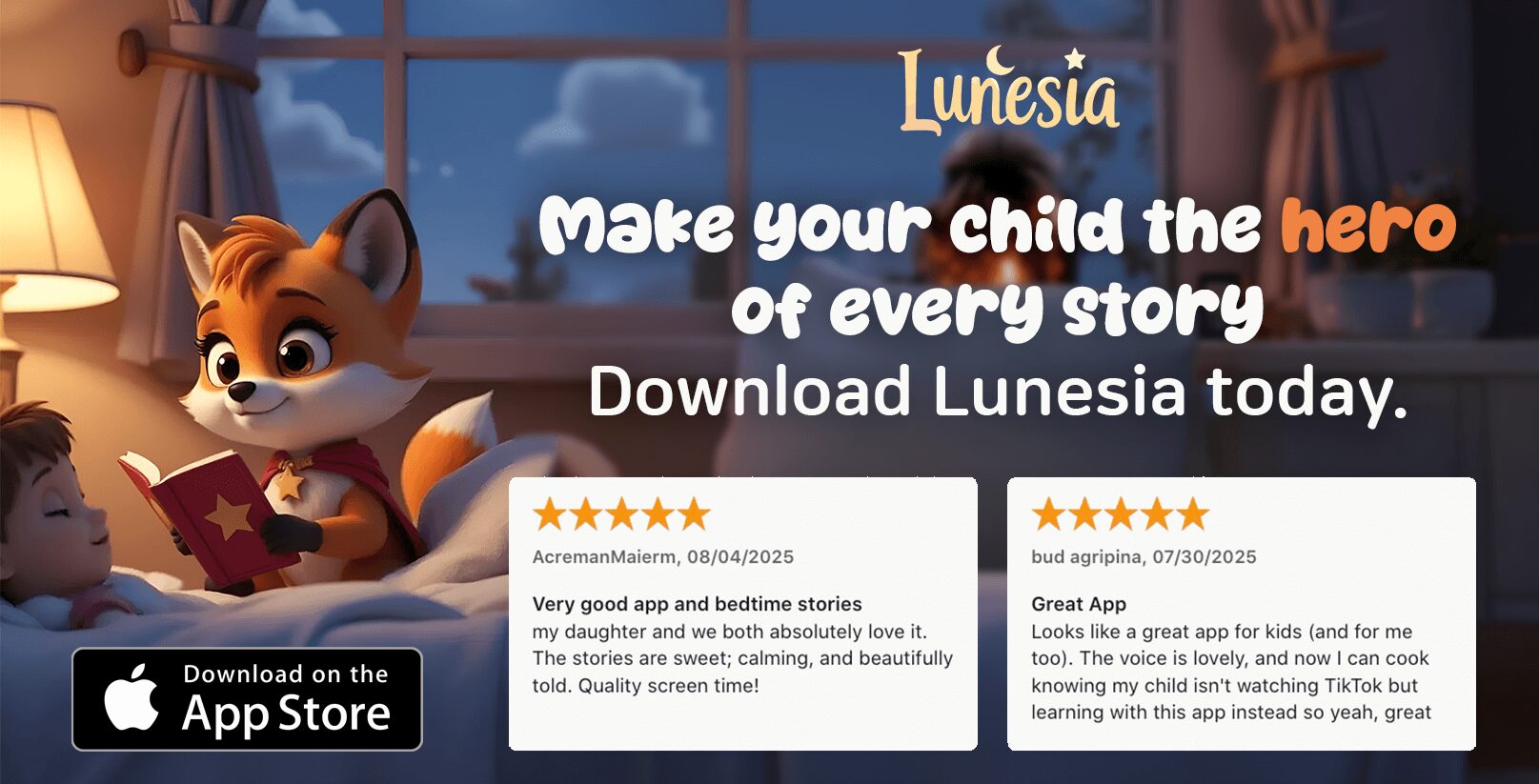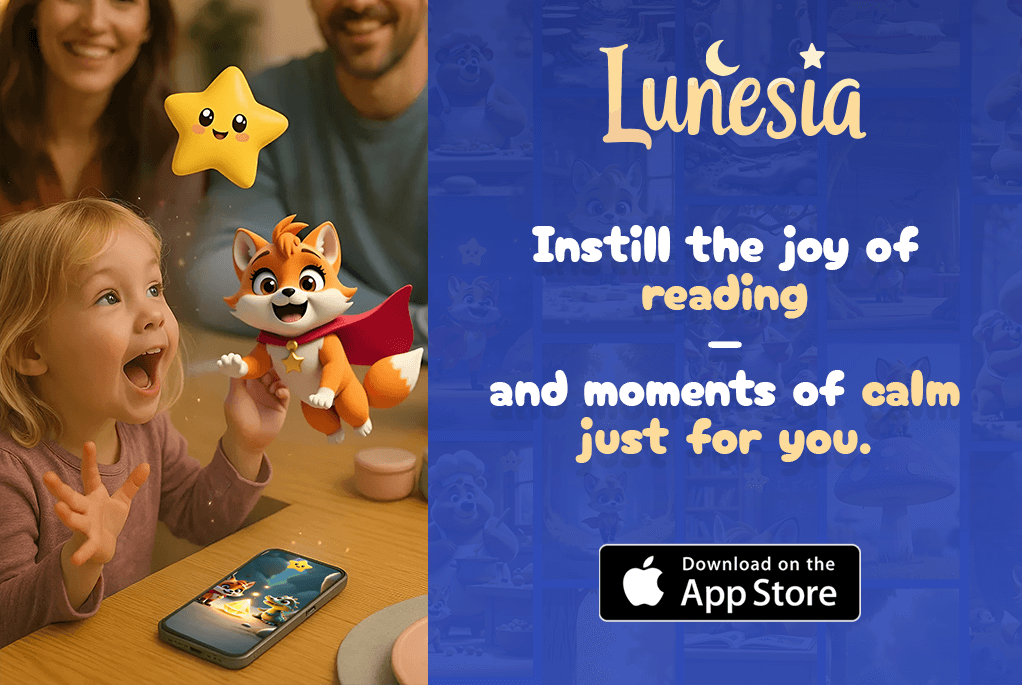As a parent, have you ever struggled to help your child wind down at night, only to be met with resistance and anxiety? You’re not alone. Many parents face the challenge of soothing their anxious kids to sleep. Bedtime anxiety can manifest in various ways, making it difficult for children to relax and fall asleep.
Traditional bedtime stories can be a great starting point, but sometimes they’re not enough. That’s where specialized stories come in – ones that directly address anxiety and fears. Lunesia has curated a collection of 10 proven stories for kids that can help.
These aren’t just any stories; they’re therapeutic tools designed to help children process their emotions and develop coping skills. In this guide, we’ll explore how each story can be a valuable resource for your child’s sleep routine.
Understanding Childhood Anxiety at Bedtime
Childhood anxiety often manifests at bedtime, making it difficult for children to relax and fall asleep. As a parent, it’s essential to understand the underlying causes of this anxiety to help your child overcome it.
Common Bedtime Fears in Children
Children often experience various fears at bedtime, including fear of the dark, monsters, being alone, separation anxiety, and fear of bad dreams. These fears are developmentally normal but can become problematic if they significantly impact sleep quality. For instance, a child might fear that if they close their eyes, their parents will disappear. Understanding these fears is the first step in addressing them.
| Common Fears | Description | Age Group |
|---|---|---|
| Fear of the Dark | Fear triggered by the absence of light | 2-5 years |
| Monsters or Imaginary Creatures | Fear of perceived threats | 3-6 years |
| Separation Anxiety | Fear of being separated from parents | 2-4 years |
How Anxiety Affects Children’s Sleep
Anxiety can significantly affect a child’s sleep cycle, leading to difficulty falling asleep, nighttime wakings, and reduced REM sleep. This not only affects their sleep quality but also their daytime functioning, emotional regulation, and overall wellbeing.Addressing bedtime anxiety early is crucialto prevent long-term sleep issues and help children develop healthy sleep associations.
By understanding the psychological underpinnings of childhood anxiety at bedtime and identifying common bedtime fears, parents can take the first steps towards helping their children overcome these challenges.
The Science Behind Calming Bedtime Stories for Anxious Kids
The science behind calming bedtime stories reveals a complex interplay of narrative structures, emotional regulation, and neurological responses in children. Bedtime stories for kids are not just a way to wind down; they’re a scientifically-backed method to help anxious children manage their fears.
How Stories Help Regulate Emotions
Research has shown that well-crafted bedtime stories can activate the parasympathetic nervous system, triggering the body’s natural relaxation response. This counteracts the fight-or-flight state common in anxiety. Stories with specific themes and narrative structures help children externalize their worries and fears, making them more manageable. The rhythmic patterns in storytelling mimic the soothing qualities of lullabies, helping to regulate breathing and heart rate in preparation for sleep.

Creating a Sense of Security Through Storytelling
Consistent storytelling routines create predictability that helps anxious children feel secure and safe at bedtime. The parent-child connection during story time releases oxytocin, the “bonding hormone,” which further promotes feelings of security and calm. Stories that model healthy emotional regulation give children tools they can apply in their own lives when facing anxious moments.
| Benefits of Bedtime Stories | Impact on Anxious Children |
|---|---|
| Emotional Regulation | Helps manage anxiety and fears |
| Predictability and Security | Creates a sense of safety at bedtime |
| Parent-Child Bonding | Releases oxytocin, promoting calm and security |
By understanding the science behind calming bedtime stories, parents can harness the power of storytelling to help their anxious kids. As we explore the world of bedtime stories, it’s clear that these narratives offer more than just a calming distraction – they provide a foundation for emotional resilience and well-being.
What Makes a Bedtime Story Effective for Anxious Children
When it comes to helping anxious kids wind down, the right bedtime story can make all the difference. The most effective stories are those that are carefully crafted to address the unique needs of anxious children.
The key to a calming narrative lies in its ability to engage a child’s imagination while promoting relaxation. Predictable story arcs, gentle pacing, and reassuring resolutions are essential elements that help children feel secure and calm.
Key Elements of Calming Narratives
Effective bedtime stories for anxious kids often feature characters that model healthy coping mechanisms, providing children with emotional tools to manage their own anxieties. Sensory-rich language is also crucial, as it engages a child’s imagination without overstimulation.
Age-Appropriate Content Considerations
When selecting bedtime stories, it’s essential to consider a child’s age and developmental stage. Story complexity should match cognitive development, with simpler narratives for younger children and more nuanced emotional content for older kids. Additionally, being mindful of a child’s specific anxiety triggers is crucial, as what calms one child might stimulate another.
1. “Pirates, Fairies, Monster Trucks, and Time Travelers”

Overview
“Pirates, Fairies, Monster Trucks, and Time Travelers” is an engaging audiobook collection that teaches children self-care, confidence, mindfulness, and positive affirmations while they drift off to sleep. This enchanting collection combines delightful tales with vital tools to conquer anxiety and nurture self-belief.
Pros
The diverse characters in this collection engage different interests while teaching consistent self-care principles. The professional narration by Kaci Flaugher adds an extra dimension of calm through vocal techniques. With a 5 out of 5 stars rating from 49 reviewers, it’s clear that parents are satisfied with its effectiveness for anxious kids.
Cons
One potential drawback is the price point of $14.95 or 1 credit. Some parents might find it expensive. Additionally, while the collection is versatile, it may not address specific anxiety types in detail.
Features
This collection stands out due to its positive affirmations woven throughout the stories and progressive relaxation techniques incorporated to help kids relax. The seamless integration of mindfulness practices and engaging adventure elements captures children’s imagination, making it an effective tool for anxious kids.
2. “Dinosaurs, Princesses, Astronauts and Ballerinas”

Overview
This diverse story collection uses popular childhood themes like dinosaurs, princesses, astronauts, and ballerinas to teach kids emotional regulation skills at bedtime. Narrated by Kaci Flaugher in English, it’s designed to simplify bedtime routines.
Pros
The collection boasts a 5 out of 5 stars rating from 49 reviewers, indicating its effectiveness. It’s included in the Plus membership, adding significant value. The stories are crafted to gradually calm children, making bedtime smoother.
Cons
Some parents might be concerned about character stereotypes. However, the stories aim to empower kids, teaching patience, confidence, calmness, and joyfulness.
Features
The narration quality is high, and the stories build upon each other to reinforce emotional skills. Priced at $14.95 or 1 credit, it’s an investment in your child’s bedtime routine. This collection is tailored to help anxious kids.
3. “Whispering Nighttime Tales with Calming Dinosaurs”

Overview
“Whispering Nighttime Tales with Calming Dinosaurs” is a specialized bedtime story collection designed for kids with anxiety and ADHD. Narrated by Barbara Fernandez, this series uses gentle dinosaur-themed stories to soothe young minds.
Pros
This collection boasts a 5 out of 5 stars rating from 50 reviewers, indicating its effectiveness. The “whispering” narrative technique creates a calming sensory experience, lowering arousal levels in anxious kids. Multiple narrators add variety to the tales.
Cons
Some children might not be interested in dinosaurs, potentially limiting the collection’s appeal. However, the gentle nature of the stories helps to mitigate this concern.
Features
The series is part of “Bedtime Stories for Kids with Anxiety and ADHD,” suggesting clinical input in its development. Available in English, it offers a valuable tool for parents seeking to establish a peaceful bedtime routine, giving credit to its creators for their thoughtful approach.
4. “Bedtime Meditations for Kids”

Learn about the ‘Bedtime Meditations for Kids’ audiobook that combines storytelling with relaxation techniques. This unique collection is designed to help anxious children relax and fall asleep faster.
Overview
This audiobook features a series of immersive stories narrated by Karen Nelson Bell in English. It’s crafted to promote relaxation and reduce anxiety in kids.
Pros
The collection teaches mindfulness skills that children can use beyond bedtime. It creates a multi-sensory experience, helping kids redirect their focus away from worries.
Cons
Some reviewers mentioned that the meditation format might not work for all children. The 3 out of 5 stars rating from 45 reviewers indicates a middle-range satisfaction level.
Features
Special Features: The narrator’s voice and pacing are designed to induce relaxation states. The stories blend narrative with guided relaxation techniques, making it a unique tool for anxious kids at bedtime.
The ‘Bedtime Meditations for Kids’ audiobook is a valuable resource for parents seeking to help their children manage anxiety. With its soothing stories and calming guidance, it’s worth considering for your child’s bedtime routine.
5. “Girl Power Bedtime Stories”

Overview
This collection of bedtime stories is specifically tailored to help girls build confidence and manage anxiety. Narrated by Maria L. Johnson, these tales are designed to empower young girls while they drift off to sleep.
Pros
The Girl Power Bedtime Stories collection has received a 5 out of 5 stars rating from 56 reviewers, indicating strong parent satisfaction. It addresses confidence-building and anxiety relief, making it a valuable resource for parents.
Cons
Some parents might be concerned that the gender-specific approach may limit its application for boys. However, the techniques used can be beneficial for children of all genders.
Features
The collection incorporates mindfulness techniques that help anxious girls recognize and manage their emotions at bedtime. It addresses social anxiety that often manifests differently in girls than boys, making it a standout resource.
6. “Empowering Bedtime Stories for Boys”

Overview
“Empowering Bedtime Stories for Boys” is a collection of tales designed to help boys overcome bedtime anxiety. Narrated by Maria L. Johnson, these stories combine mindfulness, anxiety relief, and moral lessons to make bedtime a positive experience.
Pros
This collection shines with its 5 out of 5 stars rating from 41 reviewers, indicating high parent satisfaction. It promotes healthy emotional expression in boys and makes bedtime a bonding experience.
Cons
Some parents might find the gender-specific approach limiting if they’re seeking more neutral content. However, the targeted approach helps address anxiety manifestations unique to boys.
Features
The stories tackle performance anxiety and perfectionism, common issues in boys. With its soothing narratives and positive themes, “Empowering Bedtime Stories for Boys” gives kids the tools they need to manage anxiety and develop character.
7. “Soothing Short Stories for Toddlers’ Minds”

Overview
Soothing Short Stories for Toddlers’ Minds is a collection of stories specifically designed for anxious toddlers. These ultra-short stories cater to their shorter attention spans while effectively addressing bedtime anxiety through simple, repetitive narrative structures.
Pros
This collection is developmentally appropriate for toddlers, featuring a soothing narrator and garnering a 4.5-star rating from 108 reviewers. It addresses common challenges like separation anxiety and transitional objects, promoting healthy sleep habits.
Cons
Some parents might find the stories too simplistic for older toddlers or preschoolers with advanced language skills.
Features
The collection incorporates sensory soothing elements, making it particularly effective for toddlers with anxiety. These features, combined with the narrator’s calming voice, help create a peaceful bedtime environment.
8. “Fairy Tales Compendium for Mindfulness”

The “Fairy Tales Compendium for Mindfulness” is a unique storytelling approach that combines traditional fairy tales with mindfulness techniques, designed to help anxious kids relax and fall asleep more easily.
Overview
This comprehensive collection reimagines classic fairy tales to include mindfulness elements, providing children with a soothing bedtime experience. Narrated by Jasmine Jones, it helps kids reduce stress and anxiety, promoting a calm and confident sleep.
Pros
The compendium offers a comprehensive approach to managing childhood anxiety, combining cultural literacy with emotional regulation tools. The high-quality narration and familiar fairy tale structures make it an effective resource for anxious children.
Cons
Some parents might find that traditional fairy tale elements are too stimulating or scary for their children. However, the mindfulness adaptations help mitigate this issue by promoting relaxation.
Features
This collection stands out for its use of fairy tale archetypes to help children externalize and process their anxieties. With a 4.5 out of 5 stars rating from 9 reviews, it’s clear that this compendium is a valuable tool for parents seeking to ease their child’s bedtime anxiety.
9. “Magical Sleep Visualization Stories”

Overview
“Magical Sleep Visualization Stories” is a unique collection of guided imagery tales designed to help children reduce anxiety, relax, and fall asleep fast. Narrated by Isabelle León, this English-language audiobook has garnered a 4.5-star rating from 78 reviewers.
Pros
This collection stands out for its focus on rebuilding imagination skills, helping anxious children redirect worried thoughts. The soothing narration and varied visualization scenarios make it particularly effective for kids struggling with racing thoughts at bedtime.
Cons
Some children with certain cognitive styles might struggle with visualization techniques. However, the collection’s gentle approach helps mitigate this issue.
Features
As part of the “Magical Sleep” series (Book 1), this collection promises more advanced visualization techniques in subsequent volumes. Its unique approach counters the overstimulation from electronic devices that often exacerbates bedtime anxiety in modern children.
The “Magical Sleep Visualization Stories” offers a comprehensive solution for anxious kids, combining the benefits of guided imagery with engaging storytelling. With its strong ratings and focus on rebuilding imagination skills, it’s a valuable tool for parents seeking to help their children relax and sleep better.
10. “Five-Minute Good Night Stories”

Overview
‘Five-Minute Good Night Stories’ is a collection of ultra-short stories designed to reduce anxiety in children. Narrated by Farah D, these English stories create a peaceful atmosphere, perfect for a calming bedtime routine.
Pros
The five-minute format makes these stories practical for busy families. The engaging narration and descriptive language create a multi-sensory experience, helping children relax under the twinkling stars.
Cons
Some children with severe anxiety might require more than five minutes to transition to sleep readiness. However, this collection is a great starting point for families new to anxiety-reducing bedtime stories.
Features
These stories incorporate mindfulness techniques, making them accessible for children with limited attention spans. The concise yet effective content helps kids credit the calming experience to their bedtime routine, improving sleep quality over time.
How to Incorporate Calming Bedtime Stories into Your Nightly Routine
As a parent, incorporating calming bedtime stories into your nightly routine can be a powerful tool in reducing your child’s anxiety. By creating a consistent and soothing environment, you can help your child relax and prepare for a restful night’s sleep.
Creating the Perfect Environment
To maximize the anxiety-reducing benefits of bedtime stories, it’s essential to create an optimal physical environment. This includes adjusting the lighting to a soft, calming level, maintaining a comfortable temperature, and ensuring the space is comfortable and free from distractions. By doing so, you can help your child feel secure and relaxed at home.
Timing and Consistency Tips
Timing is crucial when it comes to bedtime stories. Starting the routine early enough allows for a gradual transition, helping anxious children wind down. Consistency is also key; sticking to a regular bedtime routine helps regulate your child’s expectations and reduces anxiety. By reading stories that soothe your child’s mind, you can create a sense of security and calm, making bedtime a positive experience for your child. Make the most of this special time to bond with your child and help them develop healthy sleep habits.
By incorporating calming bedtime stories into your nightly routine, you can create a sense of predictability and calm, helping your child feel more secure and relaxed. This special time together can be a powerful way to reduce anxiety and promote a restful night’s sleep.
Combining Bedtime Stories with Other Relaxation Techniques
Enhancing bedtime stories with complementary relaxation techniques can significantly improve their effectiveness for anxious children. By combining these approaches, parents can create a powerful toolkit to help their kids relax and prepare for sleep. You can start by introducing simple techniques during or after storytelling, making it a natural part of the bedtime routine.
Gentle Breathing Exercises
Teaching gentle breathing exercises can be a great way to enhance the calming effect of bedtime stories. Techniques like “balloon breathing” or “bunny breaths” can be easily learned and practiced during story time. For example, you can pause during a story and say, “Let’s take a deep breath in like we’re blowing up a balloon, and then breathe out slowly.”
Simple Meditation Practices for Children
Simple meditation practices can also be incorporated into bedtime routines. You can guide your child to focus on the sensations in their body or the sounds around them, much like the characters in their favorite bedtime stories might do. For more ideas on relaxation techniques, visit Storybook App or explore Lunesia’s resources on bedtime tantrums.

When to Seek Professional Help for Childhood Anxiety
For some kids, bedtime anxiety can be a symptom of a deeper issue that requires professional intervention. While calming bedtime stories can be a valuable tool, they might not be enough to address more severe anxiety issues.
It’s essential to recognize the signs that your child’s anxiety needs additional support. Red flags include persistent anxiety despite consistent use of calming strategies, significant impairment in daily functioning, or anxiety accompanied by physical symptoms.
Signs That Anxiety Might Need Additional Support
If your child exhibits any of the following, it may be time to seek professional help:
- Persistent anxiety that doesn’t improve with calming strategies
- Anxiety that interferes with daily activities or sleep
- Physical symptoms such as headaches or stomachaches related to anxiety
- Avoidance behaviors due to anxiety
Resources for Parents of Anxious Children
If you’ve identified red flags in your child’s anxiety, there are several resources available to support you. Consider consulting a child psychologist or play therapist who specializes in anxiety disorders. Look for professionals with expertise in evidence-based treatments like Cognitive Behavioral Therapy (CBT) and exposure therapy.
| Resource Type | Description | Benefits |
|---|---|---|
| Child Psychologists | Specialized therapists for children’s mental health | Expert guidance on anxiety management |
| Play Therapists | Therapists using play to address emotional issues | Effective for young children, non-verbal techniques |
| Support Groups | Groups for parents to share experiences and advice | Community support, practical tips from others |
Seeking professional help is a sign of strength and good parenting, not a failure of home-based interventions like bedtime stories. By combining professional guidance with calming strategies, you can help your child overcome their fears and develop healthy sleep habits.
Why Lunesia’s Collection of Calming Bedtime Stories for Anxious Kids Stands Out

What sets Lunesia’s bedtime stories apart is their unique blend of entertainment and therapy. Lunesia’s curated collection is designed to be both engaging and calming for anxious kids.
Lunesia’s selection criteria balance entertainment value with therapeutic effectiveness, ensuring stories address different manifestations of anxiety. This allows parents to choose the most suitable stories for their child’s specific concerns.
The collection is backed by quality control measures, including testing with anxious children and feedback from child psychology professionals. Lunesia is committed to diversity and inclusion, featuring stories that represent children from all backgrounds.
To maximize effectiveness, Lunesia provides supplementary resources like parent guides and follow-up activities. Ongoing research refines their recommendations, ensuring the best possible outcomes for anxious children.
Parent Testimonials: Success Stories with Calming Bedtime Tales
Hearing from parents who’ve seen real change in their children’s bedtime struggles is truly inspiring. Many have shared how calming bedtime stories have transformed their kids’ ability to fall asleep and stay asleep.
For instance, Sarah, mother of a 6-year-old, reported that after using bedtime stories for a month, her child fell asleep 30 minutes earlier than usual. “It’s been a game-changer,” she says. “Our bedtime routine is now peaceful, and my child looks forward to stories every night.”
These tales have not only improved sleep but also reduced anxiety in kids, making bedtime a positive experience. As one parent noted, “My child now drifts off to dreams with a smile, thanks to these wonderful bedtime stories.”
Conclusion
As we conclude our journey through the world of calming bedtime stories, it’s clear that these specialized tales can be a game-changer for anxious kids. By selecting stories that specifically target anxiety, you can help your child develop emotional regulation skills. Consistency and routine are crucial. Combining bedtime stories with relaxation techniques like gentle breathing exercises enhances their effectiveness. I encourage you to explore different collections to find what resonates best with your child. You’re not alone; with the right approach, you can make a difference.
FAQ
What are the benefits of using bedtime stories to help children with anxiety?
Bedtime stories can help children relax, reduce anxiety, and develop a positive association with sleep. They can also foster a sense of security and comfort, making it easier for children to fall asleep.
How do I choose the right bedtime story for my child?
Consider your child’s age, interests, and fears when selecting a bedtime story. Opt for stories with gentle narratives, soothing imagery, and positive themes that promote relaxation and calmness.
Can bedtime stories be used in conjunction with other relaxation techniques?
Yes, combining bedtime stories with other relaxation techniques, such as gentle breathing exercises or simple meditation practices, can enhance their effectiveness in reducing anxiety and promoting a restful sleep.
How often should I read bedtime stories to my child?
Consistency is key. Reading bedtime stories at the same time every night can help establish a calming bedtime routine, signaling to your child that it’s time to sleep.
What if my child has trouble falling asleep even with bedtime stories?
If your child continues to struggle with sleep, consider consulting with a healthcare professional for guidance on addressing underlying issues. They can provide personalized recommendations and support.
Are Lunesia’s bedtime stories suitable for children of all ages?
Lunesia’s collection is designed to cater to a range of age groups, from toddlers to older children. You can explore their offerings to find the most suitable stories for your child’s age and needs.




